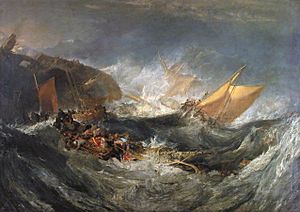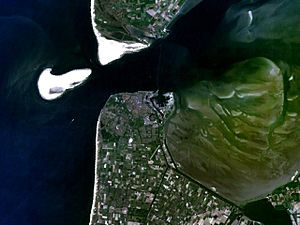HMS Minotaur (1793) facts for kids

The shipwreck of the Minotaur, oil on canvas, by J. M. W. Turner
|
|
Quick facts for kids History |
|
|---|---|
| Name | HMS Minotaur |
| Ordered | 3 December 1782 |
| Builder | William Rule, Woolwich Dockyard |
| Laid down | January 1788 |
| Launched | 6 November 1793 |
| Honours and awards |
|
| Fate | Wrecked, 22 December 1810 |
| General characteristics | |
| Class and type | Courageux-class ship of the line |
| Tons burthen | 1,723 (bm) |
| Length | 172 ft 3 in (52.50 m) (gundeck) |
| Beam | 47 ft 9 in (14.55 m) |
| Depth of hold | 20 ft 9+1⁄2 in (6.3 m) |
| Propulsion | Sails |
| Sail plan | Full-rigged ship |
| Armament |
|
HMS Minotaur was a powerful warship of the Royal Navy. She was a "74-gun ship," meaning she carried 74 cannons! Launched in 1793, she was named after the famous mythical monster from Crete. This mighty ship fought in three big battles: the Battle of the Nile, the Battle of Trafalgar, and the Battle of Copenhagen. Sadly, she was shipwrecked in 1810, and many lives were lost.
Contents
Early Actions and Captures
In 1795, Minotaur helped Porcupine get back a ship called Walsingham Packet. This ship had been captured by a French brig named Insolent. The French ship barely escaped being caught herself!
Minotaur played a big role in the Battle of the Nile in 1798. She fought alongside HMS Theseus against the French ship Aquilon. Together, they forced the French ship to surrender. In this battle, Minotaur lost 23 sailors and had 64 wounded.
In 1799, after the French gave up Rome, Captain Thomas Louis from Minotaur sailed up the Tiber River. He proudly raised the British flag over the Capitol building.
Serving in the Mediterranean
In May 1800, Minotaur became the flagship for Vice-Admiral Lord Keith. This was during the siege of Genoa, where British ships helped block the city.
In 1801, Minotaur was part of the British invasion of Egypt. She was present when troops landed at Aboukir Bay. During this campaign, three of her crew were killed and six were wounded. Because of her service in Egypt, the surviving sailors and officers later received a special medal called the Naval General Service Medal.
In 1803, Minotaur teamed up with Thunderer and Albion. They captured a French warship called Franchise. This French ship was carrying 187 men and many cannons.
Minotaur was also present when the French soldiers in Civitavecchia surrendered in 1804. She shared in the prize money from capturing the town and its fortress.
Battle of Trafalgar Heroics
Under Captain Charles John Moore Mansfield, Minotaur fought bravely at the famous Battle of Trafalgar in 1805. Captain Mansfield promised his crew he would stick to any enemy ship "till either she strikes or sinks – or I sink."
During the battle, Minotaur helped capture the Spanish ship Neptuno. After the battle, a big storm hit, and Neptuno's crew managed to take their ship back.
Captain Mansfield showed great courage by placing Minotaur between the damaged flagship Victory and an attacking French ship. For his bravery, he later received a special sword and a gold medal. These are now displayed in the National Maritime Museum.
Later Engagements
In 1807, Minotaur was the flagship for Rear-Admiral William Essington at the Battle of Copenhagen.
In 1809, during the Anglo-Russian War, boats from Minotaur and other British ships attacked Russian gunboats. This happened near Fredrickshamn in Finland. The British captured several Russian boats, but both sides had many killed and wounded. Minotaur alone lost eight men and had 30 wounded. Survivors of this action also received a special medal later.
The Tragic Shipwreck
Lost at Sea
On December 22, 1810, Minotaur was sailing from Gothenburg to Britain. It was dark and the weather was very bad. The ship, commanded by Captain John Barrett, hit a sandbank called the Haak Bank, near the Texel in the Netherlands.
Minotaur got stuck in the sand and quickly started taking on water. The crew tried to lighten the ship by cutting down the masts, but this damaged some of the lifeboats. By morning, the ship had sunk deeper, and waves were crashing over it. Around 8:00 AM, the ship split apart.
Escape and Loss of Life
The crew tried to escape using the remaining boats. Thirty-two men got away on one small boat and reached the Dutch coast. This encouraged 85 more to use another boat, and they also made it to shore.
Captain Barrett and about 100 men tried to escape on the last boat, but it was swamped by waves, and everyone on board drowned. Around 2:00 PM, the Minotaur completely overturned, and the remaining crew members were lost.
In total, between 370 and 570 men died in the shipwreck. The 110 survivors who reached shore were taken as prisoners of war by the Dutch.
Aftermath and Blame
When the prisoners were released three and a half years later, a court decided that the pilots were to blame for steering the ship into danger. They had misjudged their location because of the bad weather.
Some survivors, like Lieutenant Snell, criticized the Dutch authorities. They felt the Dutch should have sent rescue boats sooner. Snell said it would have been easy for the Dutch to save more of the crew. However, Dutch reports said that the wind and seas were too strong for their boats to approach the wreck site.
Maritime historian William Stephen Gilly later wrote in 1850 that if the Dutch had sent help, most of the crew could have been saved.
Minotaur's Lasting Legacy
Art and Rescue
The famous painter J. M. W. Turner created a painting of a shipwreck. While he first planned it as a general scene, he named it The shipwreck of the Minotaur to connect with the public interest in the recent disaster.
The sinking of Minotaur remains one of the largest shipwrecks in terms of lives lost on the Dutch coast. This tragic event, and the accusations from the British, made the Dutch realize they needed better ways to rescue sailors from shipwrecks. Because of this, the first Dutch sea-rescue organization was founded in 1824.
A Flag's Journey
A master's mate named Stephen Hilton saved the Union Jack flag from Minotaur at Trafalgar as a souvenir. His family later gave the flag to a church in Kent in 1930.
In 2011, the church sold the flag to the National Maritime Museum. After careful work to preserve it, the flag was put on display in 2015. Even after 200 years, it was in surprisingly good condition and now measures an impressive 233 by 310 centimeters.


